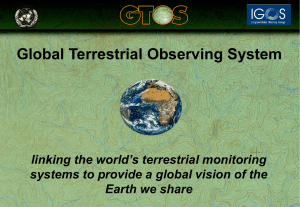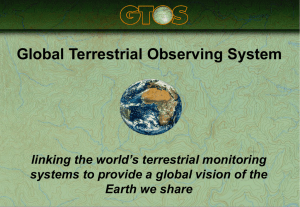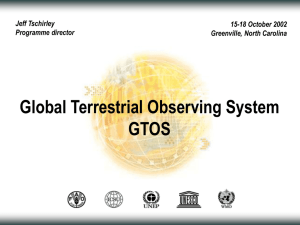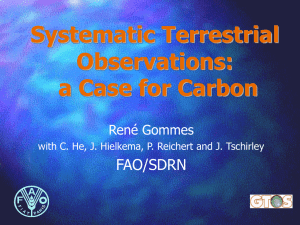Global Terrestrial Observing System linking the world’s terrestrial monitoring Earth we share
advertisement
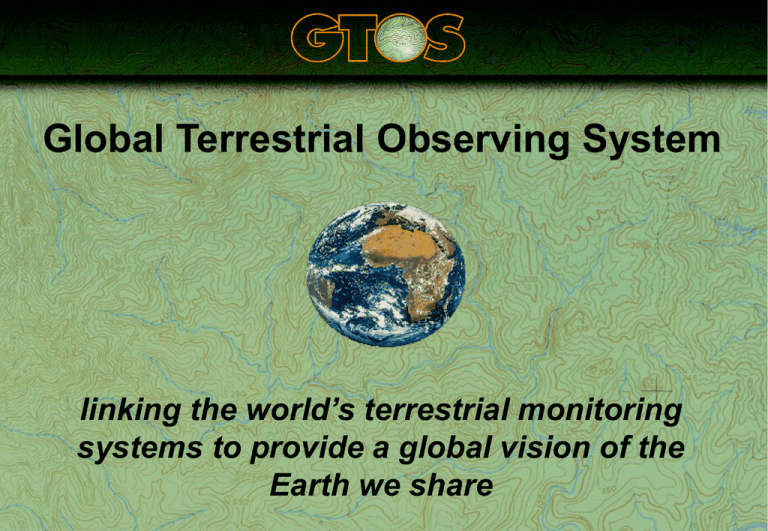
Global Terrestrial Observing System linking the world’s terrestrial monitoring systems to provide a global vision of the Earth we share GTOS Mission Statement To provide policy makers, resource managers and researchers with access to the data they need to detect, quantify, locate, understand and warn of changes (especially reductions) in the capacity of terrestrial ecosystems to support sustainable development. Focuses on five issues of global concern: 1. Changes in land quality 2. Availability of freshwater resources 3. Loss of biodiversity 4. Impacts of climate change 5. Effect of pollution and toxicity Sponsors Food and Agriculture Organization (FAO) International Council of Science Unions (ICSU) United Nations Environment Programme (UNEP) United Nations Educational, Scientific and Cultural Organization (UNESCO) World Meteorological Organization (WMO) Key partners Countries (Europe, Southern Africa, South Asia) Research institutes and universities Global change programmes (GCOS, GOOS, IGBP ... ) Committee of earth observation satellites Framework convention on climate change Convention on biodiversity The global observation hierarchy 1. Large-area experiments 2. Long-term research centres 3. Field stations 4. Periodic, unstaffed sample sites 5. Frequent low resolution remote sensing GT-Net Structure GTOS Steering Committee (GTSC) Secretariat GT-Net Panel Thematic Networks Ecology-Net Coastal-Net Glacier-Net Regional / National Networks Hydrology-Net Southern Asia Central Europe Southern Africa GT-Net demonstration project GT-Net undertakes projects which demonstrate the value of linking existing networks in order to better understand global change. It serves as a test bed for collaboration among networks and sites through data sharing and exchange, by generating data and information, and obtaining experience needed for further GT-Net development. GT-Net demonstration project The first project will improve current estimates of global net terrestrial primary productivity. It uses a hierarchical approach with models that combine satellite data with in situ observations. A set of products, which have NPP as their common foundation, will be produced. The project will: (1) distribute a standard global NPP product to regional networks for evaluation; and (2) derive regionally specific crop, range and forest yield maps for land management applications. Net Primary Productivity Critical vegetation variables such as LC, LAI and NPP are measured at local and regional scales, and used to validate the global satellite-based estimates. NEP measurements provide a separate validation and translation of the carbon budget based NPP to estimate commodity yields (with local weather data). Terrestrial carbon initiative Led by GTOS and FAO in collaboration with IGOS Partners, including UN organizations, remote sensing agencies and international research organizations such as ICSU. Aimed at developing a coordinated international response to improve scientific understanding of terrestrial carbon sources and sinks. An evolving network whereby frequent observations and computer models are used to document and understand the terrestrial component of the global carbon cycle and meet some of the carbon accounting requirements of the Kyoto protocol. Terrestrial carbon initiative Objective: Demonstrate feasibility of continuous monitoring of spatial and temporal variations of terrestrial carbon cycle by 2004 with near-km resolution and good accuracy Improve on required models and observations (site location, sensors, variables...) Terrestrial carbon initiative Characteristics: •data from a combination of remote sensing and ground-based observing systems; •operate at a relatively high resolution to use of remote and in situ observations; •produce reliable maps of terrestrial carbon sources and sinks on a seasonal, annual, inter-annual, and decadal basis by 2004. Terrestrial Ecosystem Monitoring Sites TEMS meta-database •A register of long-term terrestrial observation sites around the world •Information on more than 700 sites •Searchable on the Web: http://www.fao.org/gtos/ •Supporting GT-Net and the NPP project Value-added of GTOS •Operational links between terrestrial databases, sites, networks •Improved access to terrestrial data & information and better collaboration between networks •Filling gaps in key observations and harmonization of measurements & terminology •Stronger links between satellite and ground research (IGOS) •Stronger links between science and policy Benefits of the approach Site research •Access to imagery, data Satellite programmes •Application of research results •Broader access to data and information •Better data and new tools Access to ground validation Analysis, synthesis modelling Policy forums (COP, SBSTTA, governments)


